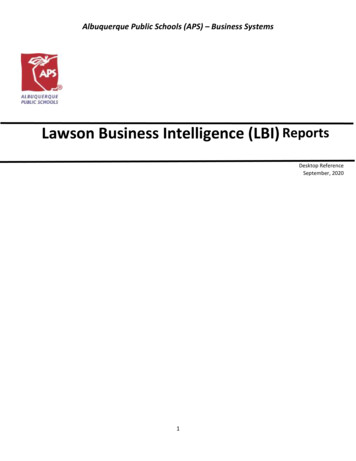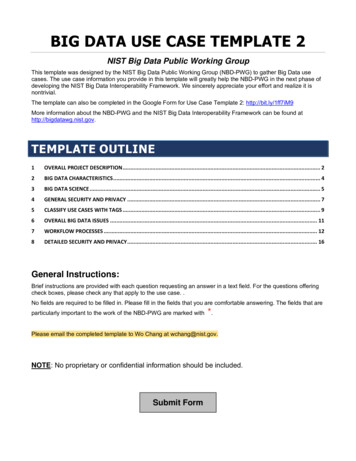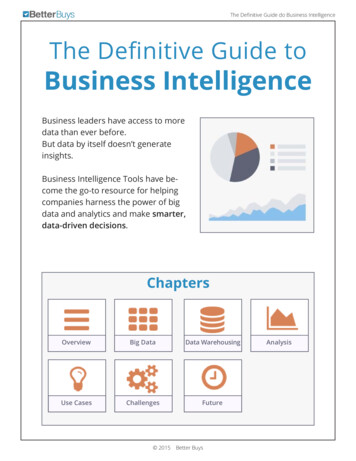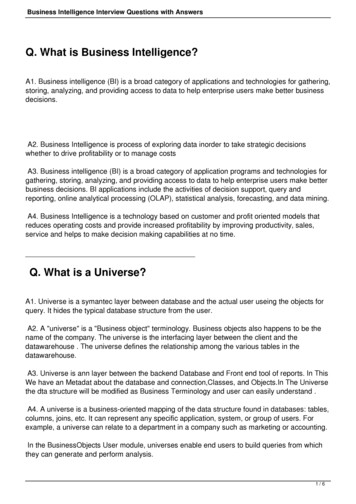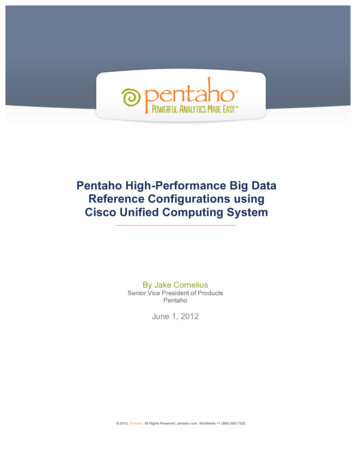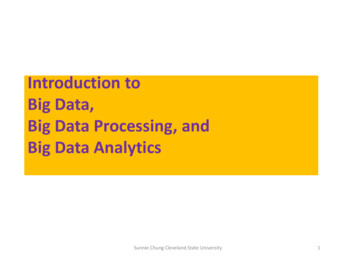
Transcription
View metadata, citation and similar papers at core.ac.ukbrought to you byCOREprovided by CSUSB ScholarWorksCommunications of the IIMAVolume 14Issue 3 Double Issue 3/4Article 12014Business Intelligence and Big Data Analytics: AnOverviewXin James HeFairfield University, xhe@fairfield.eduFollow this and additional works at: http://scholarworks.lib.csusb.edu/ciimaPart of the Management Information Systems CommonsRecommended CitationHe, Xin James (2014) "Business Intelligence and Big Data Analytics: An Overview," Communications of the IIMA: Vol. 14: Iss. 3,Article 1.Available at: /1This Article is brought to you for free and open access by CSUSB ScholarWorks. It has been accepted for inclusion in Communications of the IIMA byan authorized administrator of CSUSB ScholarWorks. For more information, please contact scholarworks@csusb.edu.
Business Intelligence and Big Data Analytics: An OverviewHeBusiness Intelligence and Big Data Analytics: An OverviewXin James HeFairfield University, USAxhe@fairfield.eduABSTRACTThis research investigates the current status of big data business analytics and critical skillsnecessary to create business value. Business analytics refers to the skills, technologies,applications and practices for continuous iterative exploration and investigation of past businessperformance to provide actionable insights. Business analytics focuses on developing new insightsand understanding of business performance based on data and statistical methods. Big data isused to characterize data sets that are large, diverse and rapidly-changing, as seen by everincreasing numbers of organizations. Big data require database management systems withcapabilities beyond those seen in standard SQL-based systems. According to Manyika et al.(2011), the projected demand for deep business analytical positions could exceed the supplyproduced with the current trend by 140,000 to 190,000 positions, in addition to the projected needof 1.5 million managers and analysts in dealing with big data business analytics in the UnitedStates. Specifically, the emphasis of this research is on how organizations are using big databusiness analytics and how business school in the United States and across the globe are designingtheir programs to fill in the talent gap, which leads to a more in-depth analysis on the graduatedegree programs in the Greater New York Metropolitan area and potential applications in variousindustries.Keywords: business intelligence, business analytics, big data analyticsINTRODUCTIONBusiness analytics refers to the skills, technologies, applications and practices for continuousiterative exploration and investigation of past business performance to provide actionable insights.Business analytics focuses on developing new insights and understanding of business performancebased on data and statistical methods. The term big data is used to characterize data sets that arelarge, diverse and rapidly-changing, as seen by ever-increasing numbers of organizations. Big datarequire database management systems with capabilities beyond those seen in standard SQL-basedsystems. According to Manyika et al. (2011), the projected demand for deep business analyticalpositions could exceed the supply produced with the current trend by 140,000 to 190,000 positions,in addition to the projected need of 1.5 million managers and analysts in dealing with big databusiness analytics in the United States. “Increasingly, top thinkers in academia and businessbelieve that analytics, especially analytics connected with big data, is going to be a driving forcein our economy and society in the next 10 to 20 years” (Kiron, Ferguson, & Prentice, 2013, p. 3).To ensure continuing relevance for organizations in the future, this research reviews the currentstatus of big data business analytics and critical skills required to create business value in realCommunications of the IIMA 201412014 Volume 14 Issue 3/4
Business Intelligence and Big Data Analytics: An OverviewHebusiness operations. Specifically, the emphasis of this research is on how organizations are usingbig data business analytics and how business school in the United States and across the globe aredesigning their programs to fill in the talent gap. Potential applications in various areas are alsodiscussed.The rest of the paper is organized as follows: Section 2 reviews the literature. Section 3 providesa detailed case analysis on graduate degree programs with respect to big data business analytics.Section 4 discusses potential applications in business analytics. Finally, Section 5 summarizes theresearch.LITERATURE REVIEWBig data refers to huge datasets that are beyond the ability of traditional database software tools tocapture, store, manage and analyze, with extreme volume, velocity, and variety (Chan, 2013).According to Das and Kumar (2013), the volume of the digital data will grow to 8 Zettabytes by2015, which is equivalent to 18 million Libraries of Congresses, 90 percent of which will beunstructured data in the next decade, including text, document, image, video, and other forms ofsocial media data.Business analytics makes extensive use of data, statistical and quantitative analysis, andexplanatory and predictive modeling to help make actionable decisions and to improve businessoperations. There are many kinds of business analytics, real-time vs. non-real-time, strategic vs.tactic, planned vs. unplanned, and structured vs. unstructured (Chan, 2012). Managers have usedbusiness analytics to inform their decision making for years. Now, they are using businessanalytics not only in analyzing past performance but also in identifying opportunities to improvefuture performance (LaValle, Lesser, Shockley, Hopkins, & Kruschsitz, 2011). According toChen, Chiang, and Storey (2012), business analytics consists of big data analytics, test analytics,web analytics, network analytics, and mobile analytics, many of which are unstructured and cannotbe analyzed by relational database management tools. Fitzgerald (2014) points out that there arethree types of career categories for graduates majoring in big data business analytics: top piermanagement consulting, financial and risk analysts, and data scientists. Wills (2014) suggests thatapplications of big data analytics in healthcare industry may begin with small data analytics sinceit is much more appropriate for healthcare managers and organizations to translate data and to haveactionable intelligence based on current infrastructure in the healthcare systems.Critical skills for business analytics include optimization analytics, descriptive analytics, andpredictive analytics. For example, Watson, Wixom, and Ariyachandra (2013) suggest thefollowing: Communication skills SQL and query skills Data mining and data warehousing Statistics skills Data visualization Text mining NoSQL skillsCommunications of the IIMA 201422014 Volume 14 Issue 3/4
Business Intelligence and Big Data Analytics: An Overview HeEmerging topicsGRADUATE PROGRAMS IN GREATER NEW YORK METROPOLITAN AREAWe list six graduate business analytics degree programs in the Greater New York Metropolitanarea, in addition to a newly launched Master of Science in Business Analytics (MSBAPM) atFairfield University’s Dolan School of Business in Fairfield, Connecticut.University of Connecticut—MS in Business Analytics and Project ManagementAbout the Program. The mission of the Master of Science in Business Analytics and ProjectManagement (MSBAPM) is to deliver a program of excellence in the study of advanced businessanalytics and project management. The program delivers a core set of advanced courses in bothbusiness analytics and project management. MSBAPM provides an integrated curriculum and aglobal perspective using evolving technology platforms to facilitate and support the learningprocess. MSBAPM is structured to provide businesses a pipeline of talented and energizedprofessionals who will create immediate value for their organization and the communities theyserve.The program requires 33 credit hours, including four 3-credit courses in business analytics, four3-credit courses in project management, and 9 credit hours in elective courses.Course Descriptions. Detailed course descriptions can be found at: usiness analytics (12 credits required)1. Business process and modeling and data management2. Predictive modeling3. Business decision modeling4. Data mining and business intelligenceProject management (12 credits required)5. Introduction to Project Management6. Project Leadership and Communications7. Project Risk and Cost Management8. Advanced ManagementFordham University—MS in Business AnalyticsAbout the Program. Fordham's Master of Science in Business Analytics (MSBA) programintegrates analytic techniques, data management, IT, modeling, and statistics to train students tobecome effective analysts and informed users of business data. MSBA students develop the skillsrequired to succeed in data-driven industries such as banking, consumer products, energy,government, health care, insurance, manufacturing and pharmaceuticals.Communications of the IIMA 201432014 Volume 14 Issue 3/4
Business Intelligence and Big Data Analytics: An OverviewHeThis program consists of 30 credits over three semesters and can be completed in one year of fulltime study or in flexible part-time study. The program starts in August and runs 12 months, fulltime, until the following August. The program is completed over three trimesters: fall, spring, andsummer.Course Descriptions. Detailed program description can be found at: http://www.bnet.fordham.edu/academics/ms programs/ms business analytics/index.aspFall term (12 credits)1. Database management2. Data warehousing3. Data mining for business4. One electiveSpring term (12 credits)5. Business analytics for managers6. Text analytics7. Web analytics8. One electiveSummer term (6 credits)9. Business performance and risk management and analytics10. One electiveStevens Institute of Technology–MS in Business Intelligence and AnalyticsAbout the Program. The market has an increasing need for professionals with data managementknowledge, analytical capability and problem-solving skills. Stevens is one of a select fewuniversities worldwide to offer a master’s degree in this emerging field. Currently, Stevens is theonly university in the New York City area to offer a business intelligence and analytics (BI&A)master’s degree intended to train students to fill the growing demand for big data analysts.This BI&A degree is a 36-credit graduate program for students who have already completed anundergraduate degree in science, mathematics, computer science, engineering or a related field.Stevens offers flexible study options for both full- and part-time students interested in advancingtheir careers within industry-specific analytical fields such as finance, information technology,telecommunications and engineering.Course Descriptions. Detailed course descriptions can be found at: . Organizational context Financial decision making2. Data management Strategic data managementCommunications of the IIMA 201442014 Volume 14 Issue 3/4
Business Intelligence and Big Data Analytics: An Overview3.4.5.6.7.8.He Data warehousing and business intelligenceOptimization and risk analysis Process analytics and optimization Financial enterprise risk engineeringStatistics Multivariate data analytics Experimental designData mining and machine learning Knowledge discovery in databases Statistical learning and analyticsSocial network analytics Social network analytics Web analyticsIndustry practicum (Select 1) Applied analytics in the life sciences Algorithmic trading strategiesElectives—Electives in additional departments are available for students who waiveone or more of the required courses (financial decision making or strategic datamanagement). To waive courses, students must have approval from a faculty advisor.A. Financea. Investment and capital marketsb. Many financial engineering electives are availableB. Information systemsa. IT strategyb. Integrating IT architecturec. Marketing onlineNew York University—MS in Business AnalyticsAbout the Program. The Master of Science in Business Analytics Program is designed with busyworking professionals in mind. Participants live and work in their home countries and attend fiveconcentrated, rigorous modules in New York and Shanghai. There is an optimization of classroomtime, with usage of distance learning between modules. The modules are time intensive so that allteaching is done in-person only. Experienced managers who can benefit from unlocking thepotential of big data. Participants come from a broad range of sectors: financial services,communications, consulting, health and pharmaceuticals, manufacturing, energy, nonprofit/NGO,education, IT, etc.This program is one year in length and starts in May of each year.Course Descriptions. Detailed module descriptions can be found at: x/index.htmThe modules in the MS in Business Analytics are spread over 12 months. Between modules,students complete approximately 20 hours of work per week on pre- and post-module tasks.Module One: New YorkCommunications of the IIMA 201452014 Volume 14 Issue 3/4
Business Intelligence and Big Data Analytics: An OverviewHe1.Digital analytics and strategy: An introduction2. Dealing with big data3. Data mining for business analytics4. Decision models5. Probabilistic models for finance6. PredictionModule Two: New York1. Data driven decision making2. Social media and digital marketing analytics3. Managing for qualityModule Three: Shanghai1. Operations analytics2. Advanced decision models3. Data visualizationModule Four: Shanghai4. Special topics in analytics: Revenue management and pricing5. Strategy, change and analytics6. Market modelingModule Five: Closing—New York City1. Strategic capstoneSt. John’s University – MBA in Business AnalyticsAbout the Program. The Master of Business Administration with a concentration in businessanalytics develops professionals with training in the emerging field of integrated statisticalanalysis, data mining, predictive modeling, business intelligence and optimization methodologieswith state-of-the-art information technology tools to automate or support decision-makingactivities in the ever-changing economy.This program option provides students with a combination of technical and managerial courseworkneeded for dealing with future challenges in the technology and data-driven global environment.Potential career options for graduates from this program include data scientist, health care analyst,statistician, predictive modeler, quantitative analyst, project manager, market research analyst,computer systems analyst and technical team leader.Course Descriptions. Detailed module descriptions can be found at: s.stjQuinnipiac University—MS in Business Analytics (Online)Communications of the IIMA 201462014 Volume 14 Issue 3/4
Business Intelligence and Big Data Analytics: An OverviewHeAbout the Program. The Master of Science in Business Analytics is 33 credits in length andprovides a strong quantitative foundation that is inclusive of advanced statistics, data mining, textmining, tools for analysis and presentation and other relevant courses. The mission of the programis to develop in working professionals the skill sets needed to address the massive amount of datathat has become universally available in order to leverage this toward successful business anddecision-making applications. Numerous business functions and industries have noted theenormous need for individuals who possess the quantitative, analytical and presentation skillsrequired to apply data to the solution of business problems, to create new business opportunitiesand to support innovative practices. These skills are also critical to decision-making in thenonprofit, governmental and educational industries as well as to entrepreneurship and smallbusiness management. All courses are offered online.Course Descriptions. Detailed module descriptions can be found at: ence-in-businessanalyticsCore courses1. BA 6102. BA 6153. CIS 6204. CIS 6275. CIS 6286. BA 6207. BA 690Statistics and probabilityPredictive modelingData managementData warehousing and data miningBusiness intelligence and data miningText miningBusiness analytics capstoneFour electives from the list below1. CIS 625ERP design and implementation2. MG 603Project management3. CIS 690Managing information technology projects4. BA 680Statistical quality control5. BA 660Optimization6. BA 650Data visualizationFairfield University—Master of Science in Business AnalyticsAbout the Program. The Master of Science in Business Analytics at Fairfield University’s DolanSchool of Business seeks to fill the talent gap in the area and to prepare graduates for this fastgrowing field by developing students’ critical skills in data and model driven management decisionmaking along with a strategic vision. The MS in business analytics is a thirty-credit program overthree semesters, and can be completed in one year of full-time study or in flexible part-time study.This program is designed for: Graduates from analytics disciplines who want to develop advanced skills to solve complexbusiness problems in light of the big data challenges Graduates with degrees in quantitative areas such business, economics, computer science,engineering and statisticsCommunications of the IIMA 201472014 Volume 14 Issue 3/4
Business Intelligence and Big Data Analytics: An Overview HeExperienced professionals seeking career advancement via specialized training.Course Descriptions. The curriculum includes 30 credits of coursework, consisting of 10 threecredit courses: nine required courses and one elective. Detailed course descriptions can be uateprograms/businessanalytics/courses/Required courses:1. QA 4002. OM 4003. IS 5004. IS 5205. OM 5256. QA 5007. OM 5008. IS 5409. IS 550Applied business statisticsOperations and supply chain managementInformation systems and database managementProject managementProcess improvement and quality managementBusiness forecasting and predictive analyticsIntroduction to business analyticsData mining and business intelligenceBusiness analytics and big data managementOne graduate elective:1. MK 520 Marketing research2. OM 535 Global logistics and supply chain management3. IS 585Contemporary topics in information systems and operations managementPOTENTIAL APPLICATIONS OF BUSINESS ANALYTICSHealthcare IndustryThe Healthcare industry is one of the largest pieces of the economic make-up of the United Stateswith 17.9 percent of the GDP or 8,500 per capita in 2010, as shown in Figure 1.With the amount of data set to increase within the industry as a result of ObamaCare, there will begreat potential for hospitals, insurers, and doctors and researchers to use business analytics toolsmore affordably and effectively to deal with the information influx and at the same time to providequality cares for the patients.Communications of the IIMA 201482014 Volume 14 Issue 3/4
Business Intelligence and Big Data Analytics: An OverviewHeFigure 1: United States Healthcare Expenditures per Capita and GDP.Supply Chain ManagementEffective use of business analytics tools would help such companies as Boeing to make rightdecisions as to how much to outsource for its Boeing 787 Dreamliner, which is designed to use 20percent less fuel and expected to be 10 percent lower in cost-per-seat mile. This brand-new productis not only a revolutionary aircraft, but also it serves as a role model with an unconventional supplychain strategy in order to drastically reduce new development cost from 10 billion to 6 billion.In fact, Boeing 787 has outsourced a full 30 percent of its parts and components that are managedby its tie-one suppliers, contrary to its Boeing 747 with only 5 percent. However, a series of supplychain delays had cost Boeing over 5 billion late delivery penalty charges, in addition to the batteryoverheating incidents in January 2013. Since outsourcing and offshoring will continue as long ascompetitive advantages exist, the real challenge is: what, how, and how much outsourcing for aspecific product to tradeoff between cost and quality (He, 2013).Risk Management in Financial IndustryBig data business analytics has the potential to help financial institutions and insurance companiesnot only describe what has already happened such as Bernie Madoff Ponzi scheme that defraudedthousands of investors of billions of dollars and global financial crisis in late 2008, but also predictCommunications of the IIMA 201492014 Volume 14 Issue 3/4
Business Intelligence and Big Data Analytics: An OverviewHehow such catastrophic disasters might be prevented from happening in the future. To that end,companies need to understand fully the impact of operational risks and how to identify such risksby means of both descriptive and predictive analytics.SUMMARYThis research provides an overview of the current status of big data business analytics, looks intocritical skills necessary to create business value, reviews graduate degree programs that offer bigdata business analytics in the Greater New York area, and discusses potential applications invarious industries. Specifically, the emphasis of this research is on how organizations are usingbig data business analytics and how business school in the United States and across the globe aredesigning their programs to fill in the talent gap.REFERENCESChan, J. O. (2012). A conceptual model for operations-analytics convergence. The Journal ofAmerican Business Review, 1(1), 223-229.Chan, J. O. (2013). An architecture for big data analytics. Communications of the IIMA, 13(2), 113.Chen, H., Chiang, R. H. L., & Storey, V. C. (2012). Business intelligence and analytics: From bigdata to big impact. MIS Quarterly, 36(4), 1165-1188.Das, T. K., & Kumar, P. M. (2013). Big data analytics: A framework for unstructured data analysis.International Journal of Engineering and Technology, 5(1), 153-156. Available i 10.1.1.411.6697&rep rep1&type pdfFitzgerald, M. (2014). Training the next generation of business analytics professionals. MIT SloanManagement Review.He, X. J. (2013). The effect of supply chain strategy on quality and U.S. competitiveness.Communications of the IIMA, 13(2), 15-27.Kiron, D., Ferguson, R. B., & Prentice, P. K. (2013). From value to vision: Reimagining thepossible with data analytics: What makes companies that are great at analytics differentfrom everyone else [White paper]. Cambridge. MA: MIT Sloan Management m/SAS/en tics-106272.pdfLaValle, S., Lesser, E., Shockley, R., Hopkins, M. S., & Kruschsitz, N. (2011, Winter). Big data,analytics and the path from insights to value. MIT Sloan Management Review, 52(2), 2132.Communications of the IIMA 2014102014 Volume 14 Issue 3/4
Business Intelligence and Big Data Analytics: An OverviewHeManyika, J., Chui, M., Brown, B., Bughin, J., Dobbs, R., Roxburgh, C., & Byers, A. H. (2011).Big data: The next frontier for innovation, competition, and productivity. San Francisco,CA: McKinsey Global Institute. Available from http://www.mckinsey.com/ GI big data full report.ashxWatson, H. J., Wixom, B. H., & Ariyachandra, T. (2013). Insights on hiring for BI and analytics.Business Intelligence Journal, 18(2), 4-7.Wills, M. J. (2014). Decisions through data: Analytics in healthcare. Journal of HealthcareManagement, 59(4), 254-262.Communications of the IIMA 2014112014 Volume 14 Issue 3/4
Business Intelligence and Big Data Analytics: An OverviewHeThis Page Was Left Blank Intentionally.Communications of the IIMA 2014122014 Volume 14 Issue 3/4
Big data refers to huge datasets that are beyond the ability of traditional database software tools to capture, store, manage and analyze, with extreme volume, velocity, and variety (Chan, 2013). According to Das and Kumar (2013), the volume of the d
